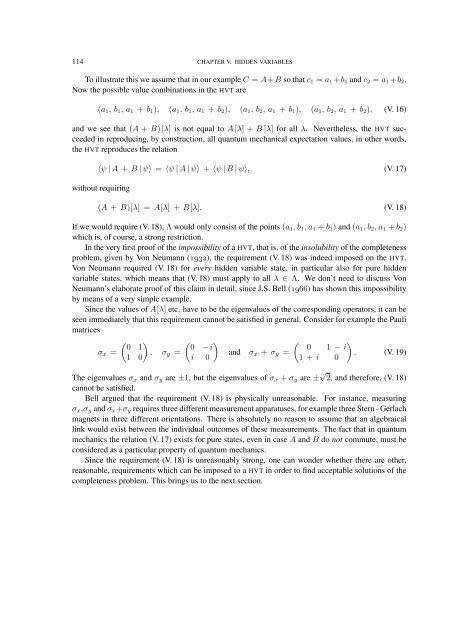FOUNDATIONS OF QUANTUM MECHANICS
FOUNDATIONS OF QUANTUM MECHANICS
FOUNDATIONS OF QUANTUM MECHANICS
You also want an ePaper? Increase the reach of your titles
YUMPU automatically turns print PDFs into web optimized ePapers that Google loves.
114 CHAPTER V. HIDDEN VARIABLES<br />
To illustrate this we assume that in our example C = A+B so that c 1 = a 1 +b 1 and c 2 = a 1 +b 2 .<br />
Now the possible value combinations in the HVT are<br />
(a 1 , b 1 , a 1 + b 1 ), (a 1 , b 1 , a 1 + b 2 ), (a 1 , b 2 , a 1 + b 1 ), (a 1 , b 2 , a 1 + b 2 ), (V. 16)<br />
and we see that (A + B) [λ] is not equal to A [λ] + B [λ] for all λ. Nevertheless, the HVT succeeded<br />
in reproducing, by construction, all quantum mechanical expectation values, in other words,<br />
the HVT reproduces the relation<br />
⟨ψ | A + B | ψ⟩ = ⟨ψ | A | ψ⟩ + ⟨ψ | B | ψ⟩, (V. 17)<br />
without requiring<br />
(A + B)[λ] = A[λ] + B[λ]. (V. 18)<br />
If we would require (V. 18), Λ would only consist of the points (a 1 , b 1 , a 1 + b 1 ) and (a 1 , b 2 , a 1 + b 2 )<br />
which is, of course, a strong restriction.<br />
In the very first proof of the impossibility of a HVT, that is, of the insolubility of the completeness<br />
problem, given by Von Neumann (1932), the requirement (V. 18) was indeed imposed on the HVT.<br />
Von Neumann required (V. 18) for every hidden variable state, in particular also for pure hidden<br />
variable states, which means that (V. 18) must apply to all λ ∈ Λ. We don’t need to discuss Von<br />
Neumann’s elaborate proof of this claim in detail, since J.S. Bell (1966) has shown this impossibility<br />
by means of a very simple example.<br />
Since the values of A[λ] etc. have to be the eigenvalues of the corresponding operators, it can be<br />
seen immediately that this requirement cannot be satisfied in general. Consider for example the Pauli<br />
matrices<br />
σ x =<br />
( ) 0 1<br />
, σ<br />
1 0 y =<br />
( ) 0 − i<br />
i 0<br />
and σ x + σ y =<br />
( )<br />
0 1 − i<br />
. (V. 19)<br />
1 + i 0<br />
The eigenvalues σ x and σ y are ±1, but the eigenvalues of σ x + σ y are ± √ 2, and therefore, (V. 18)<br />
cannot be satisfied.<br />
Bell argued that the requirement (V. 18) is physically unreasonable. For instance, measuring<br />
σ x ,σ y and σ x +σ y requires three different measurement apparatuses, for example three Stern - Gerlach<br />
magnets in three different orientations. There is absolutely no reason to assume that an algebraical<br />
link would exist between the individual outcomes of these measurements. The fact that in quantum<br />
mechanics the relation (V. 17) exists for pure states, even in case A and B do not commute, must be<br />
considered as a particular property of quantum mechanics.<br />
Since the requirement (V. 18) is unreasonably strong, one can wonder whether there are other,<br />
reasonable, requirements which can be imposed to a HVT in order to find acceptable solutions of the<br />
completeness problem. This brings us to the next section.
















